| Image | Scientific name | Common name | Distribution |
|---|
 | Pachyramphus viridis | Green-backed becard | Argentina, Bolivia, Brazil, Guyana, Paraguay, Uruguay, and Venezuela. |
 | Pachyramphus xanthogenys | Yellow-cheeked becard | south Colombia, east Ecuador, central Peru |
 | Pachyramphus versicolor | Barred becard | from Costa Rica to northwestern Ecuador and northern Bolivia. |
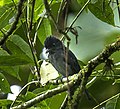 | Pachyramphus spodiurus | Slaty becard | Ecuador and far northern Peru. |
 | Pachyramphus rufus | Cinereous becard | Brazil, Colombia, Ecuador, French Guiana, Guyana, Panama, Peru, Suriname, and Venezuela |
 | Pachyramphus castaneus | Chestnut-crowned becard | Brazil, Colombia, Peru, Ecuador, and Bolivia and regions of Venezuela |
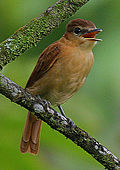 | Pachyramphus cinnamomeus | Cinnamon becard | south-eastern Mexico south to north-western Ecuador and north-western Venezuela |
 | Pachyramphus polychopterus | White-winged becard | Argentina, Belize, Bolivia, Brazil, Colombia, Costa Rica, Ecuador, French Guiana, Guatemala, Guyana, Honduras, Mexico, Nicaragua, Panama, Paraguay, Peru, Suriname, Trinidad and Tobago, Uruguay, and Venezuela. |
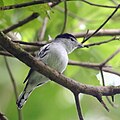 | Pachyramphus marginatus | Black-capped becard | Bolivia, Brazil, Colombia, Ecuador, French Guiana, Guyana, Peru, Suriname, and Venezuela. |
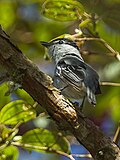 | Pachyramphus albogriseus | Black-and-white becard | Colombia, Costa Rica, Ecuador, Guatemala, Nicaragua, Panama, and Venezuela. |
 | Pachyramphus salvini | Cryptic becard | Ecuador and Peru. |
 | Pachyramphus major | Grey-collared becard | Belize, El Salvador, Guatemala, Honduras, Mexico, and Nicaragua. |
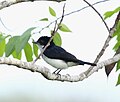 | Pachyramphus surinamus | Glossy-backed becard | Brazil, French Guiana, and Suriname. |
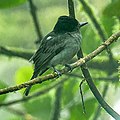 | Pachyramphus homochrous | One-colored becard | Colombia, Ecuador, Panama, Peru, and Venezuela. |
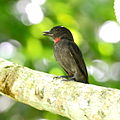 | Pachyramphus minor | Pink-throated becard | Bolivia, Brazil, Colombia, Ecuador, French Guiana, Guyana, Peru, Suriname, and Venezuela. |
 | Pachyramphus validus | Crested becard | Argentina, Bolivia, Brazil, Ecuador, Paraguay, and Peru. |
 | Pachyramphus aglaiae | Rose-throated becard | south-easternmost Arizona and extreme southern Texas of the United States to western Panama. |
 | Pachyramphus niger | Jamaican becard | Jamaica. |
|



















